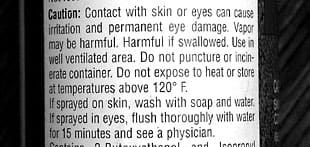Few people think about their own health when they choose household cleaners, deodorizers, and other common household products, much less their dog’s health. In fact, few people think about safety when buying household products at all, assuming that anything for sale at a grocery store must be perfectly safe, certainly safer than similar products they might find at a hardware store, for example.
Wrong, wrong, wrong!
The fact is, there are many potentially harmful household and dog-care products for sale on your grocery store and pet supply store shelves, and you can identify them by reading their labels, which, admittedly, seems to be no one’s favorite task. But it’s an important one.
Most of us have seen – if not actually read – lots of fine print on the labels of cleaning products, cosmetics, and other common household products. So it’s a good guess that even fewer people actually heed the warning statements on the labels of the chemicals they use, even though these statements appear on the labels by order of the Federal Hazardous Substances Act for our protection. Household pesticides have similar statements, by order of the Federal Insecticide, Fungicide, and Rodenticide Act.
Fortunately, concerned members of the government branches assigned to protect our health are aware of our lazy reading habits and inattention to detail.
In an attempt to make the matter of warning us about potential dangers really simple, they devised a system of classifying the relative safety level of chemical products. The warning statement on each potentially harmful household product you buy begins with one of a handful of “signal words” indicating the level of potential danger it poses.
Unfortunately, few people know about this system. Nor is its design so obvious that anyone could intuit the difference between a label that begins with the word “warning,” for example, and one that begins with “caution.” But it is worth knowing the difference, for your (human and canine) family’s health as well as for the environment.
Please don’t skip over that last statement, as overused as it might be. In addition to endangering your family’s health, hazardous products do have environmental effects. Improperly disposed, many common household products can pollute water supplies and harm plants and animals. Even when used according to label directions, some products contribute to air pollution.
Four hazard levels
The “signal word” system identifies four different levels of potential dangers posed to the consumer by non-pesticide household products (see “Pesticides and Signal Words,” next page). The four levels are:
• Danger: Indicates a product that represents the greatest potential harm to consumers and their families.
• Warning: Represents a moderate hazard.
• Caution: Indicates a mild to moderate hazard.
• No Signal Word: Indicates the product is not hazardous. (Please note: Signal words are found on labels of new household products. Products manufactured before 1987 or products not intended for household use may not contain signal words.)
Specific dangers
The “signal word” system also utilizes a few modifying words that further specify the type of hazard posed by a product: flammable, corrosive, toxic, or reactive. One of these phrases must follow the signal word. The nice simple system begins to get a little more complicated at this point, since manufacturers have a few phrases at their disposal to describe these hazards, including:
“Flammable,” “combustible,” or “contains petroleum distillates” – Indicates a product that is hazardous due to its flammability.
“Contains acid,” “contains lye,” or “causes skin to burn” – Indicates a product that is hazardous because it can burn skin or corrode other materials.
“Poison,” “Danger/Poison,” or “harmful if swallowed” – Indicates a product is toxic (poisonous) and can be harmful or fatal if swallowed, breathed in, or absorbed through the skin.
“Do not mix with . . .” – Indicates a reactive product that can explode or produce a toxic gas if combined with other substances. The most common example is mixing chlorine bleach with ammonia, which instantly produces a toxic gas.
Highest risk determines word
Toxic substances may affect humans and animals differently via different exposures: inhalation, ingestion, dermal absorption (soaking into the skin), and contact with the skin or eyes. A signal word is assigned to a pesticide product according to its highest toxicity hazard. For example, a product may be low in toxicity (“Caution”) when ingested, but moderately toxic (“Warning”) when absorbed through the skin. This product would be assigned the signal word “Warning.”
Again, note that products manufactured before 1987and those that are not intended for use in the household will not display a signal word, even if they are highly toxic.
Look for yourself
The first time I learned about signal words, I somewhat skeptically reached under my kitchen sink to examine the labels of the products I had there. I didn’t think I would find any products that contained more than the mildest warnings, and I thought that the cleaning product I bought in a health food stores would contain no warning at all.
I was surprised to find products that represented all the hazards described above, including “Caution” (Static Guard, Simple Green); “Warning” (Lysol Disinfectant Spray); and “Danger” (Easy Off Oven Cleaner, Goo-Gone).
Naturally, the next thing I had to do was to race over to my local pet store, to look at the dog-care products on the shelves. Would they, too, reveal a number of signal words?
Of course the shelves containing the flea and tick products displayed a number of “Caution” and “Warning” indicators. And the insect repellents designed to keep flies and mosquitoes off dogs had some, too. But I also found signal words on dog colognes and odor removers.
Buy least harmful products
What was most interesting was the fact that in each product section where I found a signal word on a product label, there was another product designed to do the same thing without a signal word. Remember, on a new (anything made since 1987) household product, the lack of a signal word indicates that the product poses either no hazard (in the case of nonpesticide products) or the lowest possible hazard (in the case of pesticide products).
So, all by myself, I determined that a great recommendation would be to always look for household and dog care products that display no signal words.
Back in my office, more closely reading materials published by the U.S. Environmental Protection Agency, I saw that this is, in fact, the suggestion of the EPA. “Choose the least toxic pesticide that will achieve the results you want and be the least toxic to you and the environment,” it says, right there in its Citizen’s Guide to Pest Control and Pesticide Safety. I also found several publications produced by various state health departments suggesting that consumers purchase household cleaning products with the lowest level of hazard, or make their own nontoxic products.
Remember, regardless of the signal word used on a product, all signalled products have the potential to poison you or your dog, if exposed to a high enough dose.
Also With This Article
Click here to view “Dog-Safe House Cleaning Products”
-by Nancy Kerns






